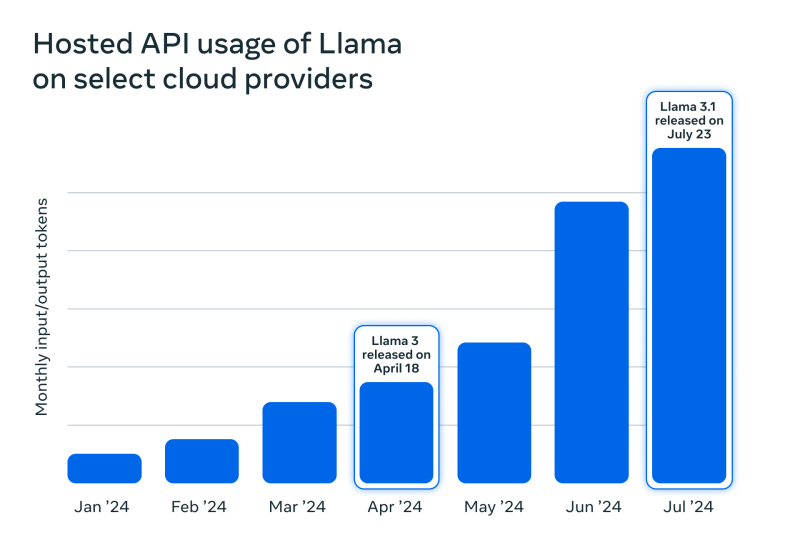Meta leads open-source AI boom, Llama downloads surge 10x year-over-year
Join our daily and weekly newsletters for the latest updates and exclusive content on industry-leading AI coverage. Learn More
Open-source AI is finally closing in on the dominance of closed-source. Today, Meta, one of the leading players in the open model category, shared a mid-year update claiming that the adoption of its Llama family of models has surged to new heights, especially since the release of the large Llama 3.1 last month.
The Mark Zuckerberg-led company revealed that the downloads for Llama models are approaching 350 million on Hugging Face, marking an over ten-fold increase from a year ago. It also noted that the adoption of the models has grown significantly – both via Hugging Face and distribution partners – with large enterprises like Zoom, Spotify, Infosys, AT&T and Goldman Sachs using them across internal and external use cases.
The update shows that open-source AI, which was initially off to a slow start, is not only matching closed-source in terms of performance but also getting significant traction at the enterprise level, powering real applications. It also questions the lead of OpenAI, which has been called out for failing to deliver frontier AI products beyond announcements.
While OpenAI had a headstart in the generative AI game, Meta was quick to jump on the bandwagon with its Llama model. The company launched the model three months after the one behind ChatGPT. However, instead of going closed-source, it focused on an open approach, making its ecosystem – covering Llama 2, Llama 3, and most recently Llama 3.1 – available via both Hugging Face and cloud partners.
“By making our Llama models openly available we’ve seen a vibrant and diverse AI ecosystem come to life where developers have more choice and capability than ever before. The innovation has been broad and rapid, from start-ups pushing new boundaries to enterprises of all sizes using Llama…,” the company wrote in a blog post today.
French startup Mistral has also followed the same strategy for many of its models. This has given developers multiple, powerful open models to build upon and create derivatives achieving parity or even outperforming closed models on select metrics (see FinGPT, BioBert, Defog SQLCoder and Phind).
For Meta, the open strategy started gaining traction only after the launch of Llama 2 in July last year. Since the launch, the downloads for the company’s models have surged more than 10x on Hugging Face, touching nearly 350 million. Last month, the company saw more than 20 million downloads on the platform — which shows a further increase in traction coming from the recent release of Llama 3.1 405B.
“We’re seeing growing preference in the developer community for Llama and strong indicators for continued growth. According to a survey from Artificial Analysis, an independent site for AI benchmarking, Llama was the number two most considered model and the industry leader in open source,” the company added.
Among the enterprises tapping the Llama family of models for internal and external use cases are AT&T, DoorDash, Goldman Sachs, Niantic, Nomura, Shopify, Spotify, Zoom, Infosys and KPMG.
Many enterprise developers are also tapping Llama models via Meta’s expansive network of cloud and infrastructure providers, AWS, Microsoft Azure, Google Cloud, Groq, Nvidia, Databricks and Snowflake. The company did not share partner-specific numbers but it did confirm that Llama’s monthly usage (by the volume of input/output tokens) grew ten-fold from January to July 2024 for select cloud service providers.

The stats seem to show that hosted Llama usage has been growing consistently (peaking in July when Llama 3.1 was released) but it is important to note that these figures are only for some of the company’s largest cloud service providers, not all partners.
This means the actual monthly usage stats may vary.
Pressure on OpenAI, Anthropic
Either way, Llama’s adoption by leading enterprises like AT&T and Spotify shows that open-source AI is catching up quickly. The recent improvements in performance and long-term cost benefits of the open approach are among the biggest factors driving this shift. With further developments in the coming months, we can expect open-source AI to completely take on the domination of closed models. This will put pressure on companies offering closed models, pushing them to innovate more and further cut down the cost of using their models.
Notably, the impact of the open-source movement can already be seen. OpenAI, which triggered the generative AI wave, has significantly cut the prices of its existing models, including GPT-4o.
However, in terms of product innovation, the Sam Altman-led research lab appears to be lagging now. All the cutting-edge AI products it has announced so far, including Sora and SearchGPT, either remain unreleased or available only to a select group of users.
Source link



